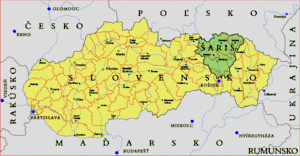| Sáros County | |
|---|---|
| County of the Kingdom of Hungary | |
| 13th century–1920 | |
_v1.svg.png.webp) Coat of arms
| |
 | |
| Capital | Eperjes |
| Area | |
| • Coordinates | 49°0′N 21°14′E / 49.000°N 21.233°E |
• 1910 | 3,652 km2 (1,410 sq mi) |
| Population | |
• 1910 | 174600 |
| History | |
• Established | 13th century |
• Treaty of Trianon | 4 June 1920 |
| Today part of | Slovakia |
| Prešov is the current name of the capital. | |
Sáros (-Hungarian, Slovak: Šariš, Latin: comitatus Sarossiensis, German: Scharosch) was an administrative county (comitatus) of the Kingdom of Hungary. Its territory is now in northeastern Slovakia. Today, Šariš is only an informal designation of the corresponding territory.
Geography

Sáros county shared borders with the Austrian crownland Galicia and the Hungarian counties Szepes, Abaúj-Torna and Zemplén. It was situated between the Levoča Hills (i.e., Szepesség (Spiš)), Kassa and Felső-Szvidnyik. The river Tarca flowed through the county. Its area was 3,652 km2 around 1910.
Capitals
The capital of Sáros county was Sáros Castle. After various other towns, since 1647 the capital has been Eperjes.

History
Sáros county was created in the 13th century from the comitatus Novi Castri (Újvár County, named after Novum Castrum, today Abaújvár) which included also the territories of the later counties of Abaúj and Heves.
In the aftermath of World War I, most of Sáros county became part of newly formed Czechoslovakia, as recognized by the concerned states in the 1920 Treaty of Trianon. During World War II, when Czechoslovakia was divided, Šariš became part of the First Slovak Republic. Since 1993, Šariš has been part of Slovakia, located in the Prešov Region. Historically a prosperous region, it is nowadays relatively poor.
Demographics

| Census | Total | Slovak | Ruthenian | Hungarian | German | Other or unknown |
|---|---|---|---|---|---|---|
| 1880[1] | 168,013 | 115,470 (70.84%) | 30,898 (18.96%) | 4,226 (2.59%) | 10,699 (6.56%) | 1,706 (1.05%) |
| 1890[2] | 168,021 | 112,331 (66.86%) | 35,019 (20.84%) | 5,708 (3.40%) | 11,811 (7.03%) | 3,152 (1.88%) |
| 1900[3] | 174,470 | 115,141 (65.99%) | 33,988 (19.48%) | 10,926 (6.26%) | 10,886 (6.24%) | 3,529 (2.02%) |
| 1910[4] | 174,620 | 101,855 (58.33%) | 38,500 (22.05%) | 18,088 (10.36%) | 9,447 (5.41%) | 6,730 (3.85%) |
| Census | Total | Roman Catholic | Greek Catholic | Lutheran | Jewish | Other or unknown |
|---|---|---|---|---|---|---|
| 1880 | 168,013 | 88,828 (52.87%) | 51,361 (30.57%) | 14,741 (8.77%) | 12,735 (7.58%) | 348 (0.21%) |
| 1890 | 168,021 | 89,805 (53.45%) | 51,855 (30.86%) | 14,267 (8.49%) | 11,822 (7.04%) | 272 (0.16%) |
| 1900 | 174,470 | 93,753 (53.74%) | 53,434 (30.63%) | 14,494 (8.31%) | 12,262 (7.03%) | 527 (0.30%) |
| 1910 | 174,620 | 94,223 (53.96%) | 52,938 (30.32%) | 14,224 (8.15%) | 12,323 (7.06%) | 912 (0.52%) |
Subdivisions

In the early 20th century, the subdivisions of Sáros county were:
| Districts (járás) | |
|---|---|
| District | Capital |
| Bártfa | Bártfa (now Bardejov) |
| Eperjes | Eperjes (now Prešov) |
| Felsővízköz | Felsővízköz (now Svidník) |
| Girált | Girált (now Giraltovce) |
| Héthárs | Héthárs (now Lipany) |
| Kisszeben | Kisszeben (now Sabinov) |
| Lemes | Lemes (now Lemešany) |
| Urban districts (rendezett tanácsú város) | |
| Bártfa (now Bardejov) | |
| Eperjes (now Prešov) | |
| Kisszeben (now Sabinov) | |
Notes
References
- ↑ "Az 1881. év elején végrehajtott népszámlálás főbb eredményei megyék és községek szerint rendezve, II. kötet (1882)". library.hungaricana.hu. Retrieved 28 September 2021.
- ↑ "A Magyar Korona országainak helységnévtára (1892)". library.hungaricana.hu. Retrieved 29 September 2021.
- ↑ "A MAGYAR KORONA ORSZÁGAINAK 1900". library.hungaricana.hu. Retrieved 29 September 2021.
- ↑ "KlimoTheca :: Könyvtár". Kt.lib.pte.hu. Retrieved 29 September 2021.
